WORLD CLASS COACHING
40 Group and Tactical Defending Exercises
By Luca Bertolini
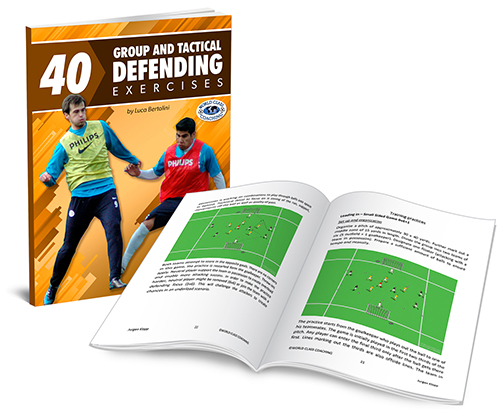
Table of Contents
PART THREE
Defending With and Against the 4-4-2
1-4-4-2
Exercise 19: 4 v 4 (1)
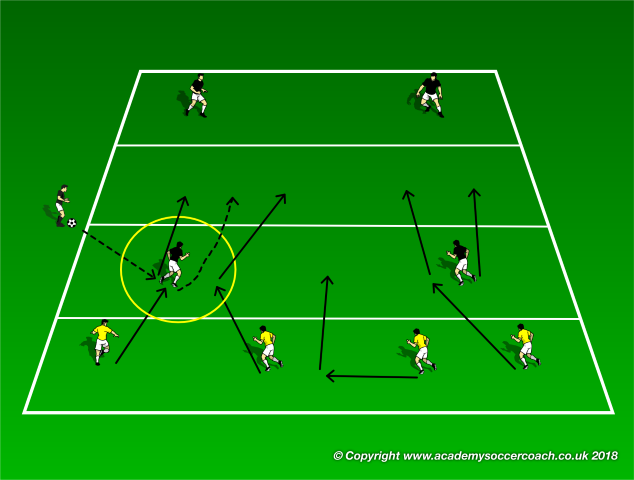
Set-up and Sequence: a rectangular area is divided into 4 parts and 8 players are involved in the exercise. 4 players of the yellow defending team are placed inside the lower area, 2 of the black possession team are placed inside the next one and the last 2 inside the further zone, as in the picture.
The coach has the ball and he decides whether to pass to the closer black couple, as in the picture, or to play toward the upper couple. The defenders must run up through the areas to put pressure or to close the space, depending on who is the couple in possession:
1) If the coach passes the ball to the nearest couple, as in the picture, the 4 defenders must press them, doubling the mark on the opponents to recover the possession, being in numerical advantage 4 v 2. They must prevent the black players from turning and dribbling over the end line.
2) If the coach passes the ball toward the further couple, the 4 defenders must run up quickly, to close the passing lanes from inside the third part of the pitch, preventing them from passing forward toward the other teammates. If possible, the defenders can try to recover the possession, as they are in numerical advantage.
Defense transition phase:
1) If the defenders win the ball, they must dribble over the opposite end line. The black couple of players who lost the possession must try to counter the new ball carrier and the other 2 must run up to equalize the duel near the ball (4 v 4).
2) If the defenders are able to recover the possession against the further opponents, the couple of players who lost the possession must try to cover the depth while they are waiting for the other teammates, who must retreat to equalize the duel (4 v 4).
Tactical key points: pressure, space cover, passing lanes closure, retreat to support the defense phase.
Exercise 20: 4 v 4 (2)
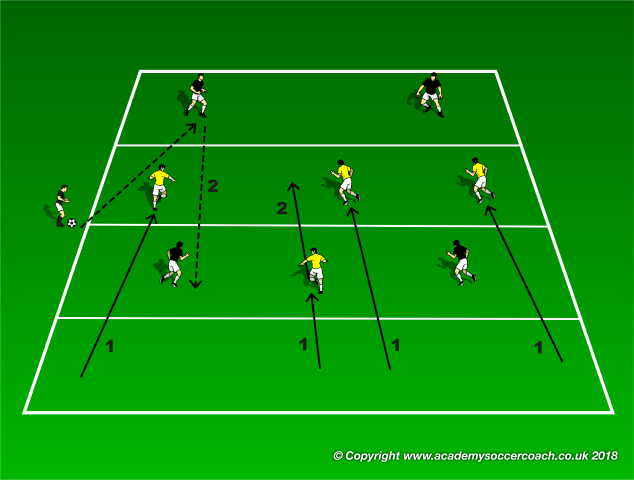
Set-up and Sequence: this exercise is a progression of the previous one. A rectangular area is again divided into 4 parts and 8 players are involved in the exercise. 4 players of the yellow defending team are placed inside the lower area, 2 of the black possession team are placed inside the next one and the last 2 inside the further zone, as in the picture.
The coach has the ball and he decides whether to pass to the closer black couple or to play toward the upper couple; the defenders must run up through the areas to put pressure or to close the space depending on where the coach passes the ball, leaving always a balance player at the back in the first phase (1):
1) If the coach passes to the couple of opponent inside the second area, 3 of the 4 defenders must press them, doubling the mark on the ball carrier to recover the possession, being in numerical advantage 3 v 2. They must prevent the black players from turning and dribbling over the end line, leaving a balance player inside the first area.
2) If the coach passes the ball toward the further couple, again 3 of the 4 defenders must run up quickly, to close the passing lanes from inside the third part of the pitch, preventing them from passing forward toward the other teammates. The fourth defender must provide balance at the back; he can press too, but only if there a clear chance to recover the possession, freeing the opponents at his back and creating a 4 v 2 situation.
Defense transition phase:
1) If the defenders win the ball, they must dribble over the opposite end line. The black couple of players who lost the possession must try to counter the new ball carrier and the other 2 must run, equalizing the duel near the ball (4 v 4).
2) If the defenders are able to recover the possession against the further opponents, the couple of players who lost the possession must try to cover the depth, delaying the opposition's possession phase, while they are waiting for the other teammates, who must retreat to equalize the duel again (4 v 4).
Tactical key points: pressure, balance behind the pressing area, passing lanes closure, patience and delay when outnumbered, retreat to support the defense phase.
Exercise 21: 4 v 2 + 4 v 2 (1)

Set-up and Sequence: a rectangular area is divided into 2 parts and 12 players are involved in the exercise. 4 defending players of the each team are placed inside both the areas, as well as 2 forwards, as in the picture.
The coach has the ball and he decides who is the possession team (the black one in the picture); the forwards of the defending team must press immediately the ball carrier, while he's receiving and the back 4 must run up to avoid any deep pass; moreover the center backs must be placed in front of the forwards to try to anticipate them.
Defense transition phase:
1) If the first 2 defenders win the ball, they must try to dribble over the opposite end line within 6". The 4 black players who lost the possession must try to counter them directly, forcing the possession backward and recovering the possession, being in numerical advantage (4 v 2).
2) If the new couple of players in possession pass back, making the other 4 teammates active, or if the ball is won by the 4 defenders at the back, then a 6 v 6 possession game is created to dribble over the opposite end line, at the back of the opposition defense line. The defending team must then balance pressure and space coverage.
Tactical key points: pressure on the ball carrier, anticipation, balance between pressure actions and space coverage during the defense phase.
Exercise 22: 4 v 2 + 4 v 2 (2)
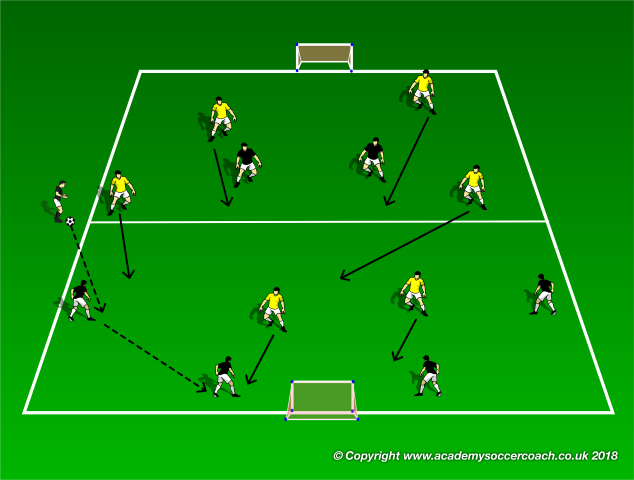
Set-up and Sequence: this exercise is a progression of the previous one. A rectangular area is divided into 2 parts and 12 players are involved in the exercise. 4 defending players of the each team are placed inside both the areas, as well as 2 forwards, as in the picture.
The coach has the ball and he decides who is the possession team (the black one in the picture); the forwards of the defending team must press immediately the ball carrier, while he's receiving and the back 4 must run up to avoid any deep pass. The wide defenders must run inside the opposite half, one of them must support the pressure phase and the second one must place himself at the back of the pressure area, to provide balance; a 4 v 4 duel is then created. The center backs must be placed in front of the forwards to try to anticipate them.
Defense transition phase:
1) If the first 4 defenders (2+2) win the ball, they must try to dribble over the opposite end line within 6". The 4 black players who lost the possession must try to counter them directly, forcing the possession backward and recovering the possession, waiting for the teammates, who can retreat to create defense numerical advantage (6 v 4).
2) If the new players in possession decide to pass back, or if they are forced backward, making the other 2 teammates active, or if the ball is won by the 2 defenders at the back (2 v 2 duel), then a 6 v 6 possession game is created to dribble over the opposite end line at the back of the opposition defense. The defending team must then balance pressure and space coverage.
Tactical key points: pressure on the ball carrier, balance between pressure actions and space coverage, numerical advantage creation.
Exercise 23: 4 v 2 + 4 v 2 (+ 2)
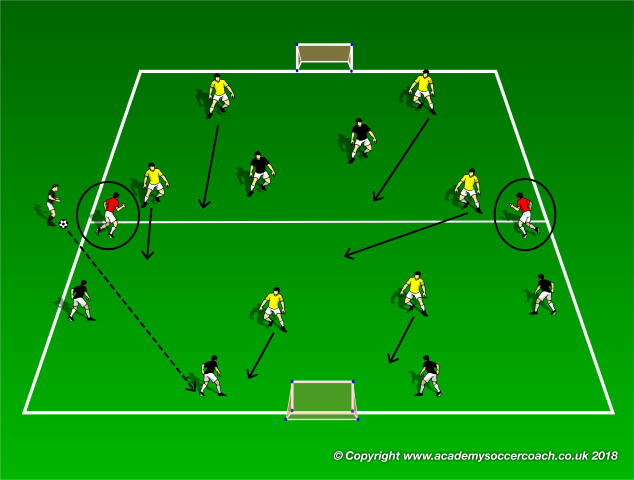
Set-up and Sequence: a rectangular area is divided into 2 parts and 14 players are involved in the exercise. 4 defending players of the each team are placed inside both the areas, as well as 2 forwards, as in the picture. 2 red free players are placed wide on the middle line, supporting the possession team.
The coach has the ball and he decides who is the possession team (the black one in the picture); the forwards of the defending team must press immediately the ball carrier while he's receiving, and the back 4 must run up to avoid any deep or wide (toward the free players) pass. The wide defenders must run inside the opposite half, one of them must support the pressure phase and the second one must place himself at the back of the ultra-offensive pressure area, to provide balance; a 4 v 4 duel is then created. The center backs must be placed between the forwards and the free players to be able to delay them if they receive the ball.
Defense transition phase:
1) If the first 4 defenders (2+2) win the ball, they must try to dribble over the opposite end line within 6". The 4 black players who lost the possession must try to counter them directly, forcing the possession backward and recovering the possession, waiting for the teammates, who can retreat to create defense numerical advantage (6 v 4).
2) If the players now in possession decide to pass the ball toward the free ones or if they are forced backward, making them active in the new possession phase, then a 6 v 6 possession game is created to dribble over the opposite end line, at the back of the opposition defense line. The defending team must then balance pressure and space coverage. The center backs must stay placed on the middle line or just behind it to provide balance.
3) If the ball is won by the 2 defenders at the back (2 v 2 duel), an 8 v 6 duel is created on the pitch. The defending team is outnumbered and its player must try to delay the opposition possession phase and to cover the depth, to avoid any ball dribble over the end line.
Tactical key points: pressure on the ball carrier, ultra-offensive pressure, balance positions and between pressure actions and space coverage, delay and space coverage when outnumbered.
Exercise 24: 4 v 2 + 4 v 2 (2 + 2)
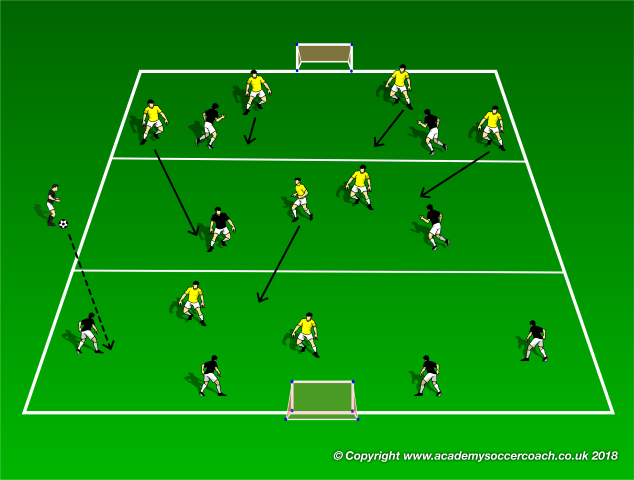
Set-up and Sequence: a rectangular area is divided into 2 parts and 14 players are involved in the exercise. 4 defending players of the each team are placed inside both the areas, as well as 2 forwards, as in the picture. 2 red free players are placed wide on the middle line, supporting the possession team.
The coach has the ball and he decides who is the possession team (the black one in the picture); the forwards of the defending team must press immediately the ball carrier, while he's receiving and the back 4 must run up to avoid any deep or wide (toward the free players) pass. The wide defenders must run inside the opposite half, one of them must support the pressure phase and the second one must place himself at the back of the ultra-offensive pressure area, to provide balance; a 4 v 4 duel is then created. The center backs must be placed between the forwards and the free players, to be able to delay them if they receive the ball.
Defense transition phase:
1) If the first 4 defenders (2+2) win the ball, they must try to dribble over the opposite end line within 6". The 4 black players who lost the possession must try to counter them directly, forcing the possession backward and recovering the possession, waiting for the teammates, who can retreat to create defense numerical advantage (6 v 4).
2) If the new players in possession decide to pass the ball toward the free players, or if they are forced backward, making them active in the new possession phase, then a 6 v 6 possession game is created to dribble over the opposite end line, at the back of the opposition defense. The defending team must then balance pressure and space coverage. The center backs must stay placed on the middle line, or just behind it, to provide balance
3) If the ball is won by the 2 defenders at the back (2 v 2 duel), an 8 v 6 duel is created on the pitch. The defending team is outnumbered and its players must try to delay the opposition possession phase and to cover the depth to avoid any ball dribble over the end line.
Tactical key points: pressure on the ball carrier, ultra-offensive pressure, closure of passing lanes, balance positions and between pressure actions and space coverage, delay, space and depth coverage when outnumbered.
Exercise 25: 4 v 2 + 4 v 2 (+ 2) and gks
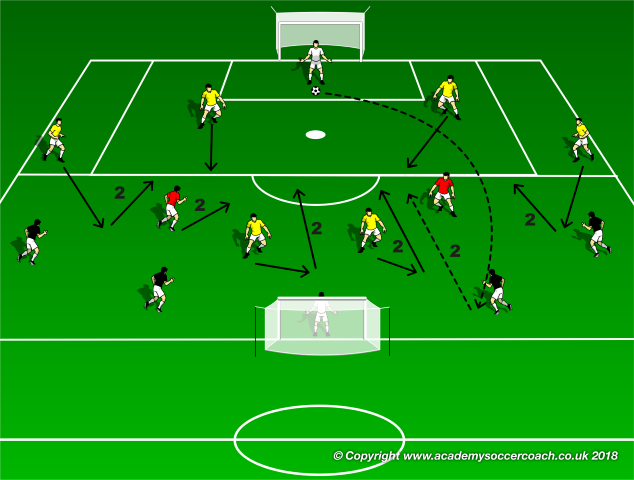
Set-up and Sequence: 12 field players and 2 goalkeepers are placed inside 1/3 of a regular field that is divided into 2 parts; the defending half is as long as the penalty area, and the end line of the building up area is the same of the third of the field. The yellow defending team is shaped with 4 defenders and 2 advanced players; the attacking team has 4 players at the back and 2 red free players support them.
The goalkeeper of the yellow team starts the sequence, passing the ball to a black player to build up inside the first third; the advanced yellow players of the defending team must put pressure against the 4 black opponents, condensing the ball area and forcing the opposition building up phase outside to prevent them from playing at the back and toward the red free players.
2 wide yellow defenders must run inside from the second half to help the teammates, being balanced between the wide opponents and the red free players; the defenders are outnumbered 4+2 v 4. The center defenders must stay placed on the borderline of the penalty area to close the goal area.
If the black players are able to pass the ball forward and to play inside the finishing area, the 6 yellow defenders must condense the ball area, to prevent any finishing phase; the 4 advanced defenders must retreat their positions (2).
Defense transition phases:
1) If the advanced players of the defending team win the ball, they can play together with the red free players and the incoming teammates; the black players, now without possession, are outnumbered and they must cover the goal space to prevent any finishing chance.
2) If the possession is recovered at the back, the red free players become defenders together with the black ones and a 6 v 6 duel is created; the red free players are asked to counter press the opposition while the back 4 are running up the pitch.
Variation: wherever the defending team recovers the possession, the red free players are always a support for the attacking team. In this case the 4 black players must defend the goal as a block to try to avoid shooting chances.
Tactical key points: condense the ball area, support the pressure from the back, counter pressing, retreat to cover the depth, overload the center space and delay if outnumbered.
Exercise 26: 4 v 2 + 4 v 4 and gks (1)
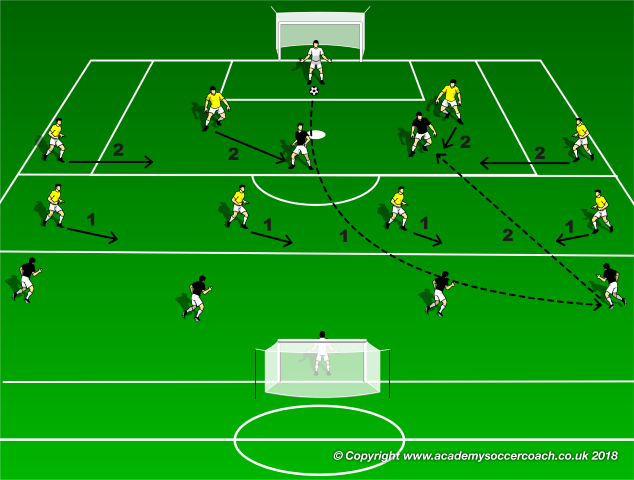
Set-up and Sequence: 14 field players and 2 goalkeepers are placed inside an area about 10 yards less than a half of a regular field (or on half of a field) that is divided into 3 parts, as in the picture. The black attacking team is shaped with 4 defenders (inside the first third) and 2 forwards (free to move inside the final third). The yellow team is shaped with 4 defenders inside the first third and 4 midfielders inside the middle third area of the space. The goalkeeper of the yellow team has the possession at the beginning. The attacking players can't play out of their areas when in possession.
The goalkeeper starts the sequence, kicking the ball to a fullback of the black team, who must receive and try to play in behind the lines toward the forward, as soon as possible; the midfielders of the defending team must put pressure against the 4 black opponents, moreover on the ball carrier, condensing the ball area and forcing the opposition building up phase backward or outside, to prevent them from playing toward the forwards (1).
If the black forwards are able to receive, the yellow defenders must press them to force them backward and toward the midfielders, who are retreating to recover the possession.
Defense transition phases:
1) If the yellow midfielders are able to recover the possession, they can counter attack; the 4 blacks at the back must counter them, delaying the attacking phase and waiting for 2 teammates retreating, to support the defense phase and to create numerical advantage, after 6".
2) If the yellow defenders recover the possession, they must pass the ball to the midfielders to try to score. The black defenders must counter them, running inside the middle area, and pressing them to avoid any further pass. The yellow forwards must run back to create defensive numerical advantage 6 v 4.
Tactical key points: pressure to close the passing lanes and to recover the ball, delay the opposition possession waiting for support, condense the ball area to prevent forward passes.
Exercise 27: 4 v 2 + 4 v 4 and gks (2)
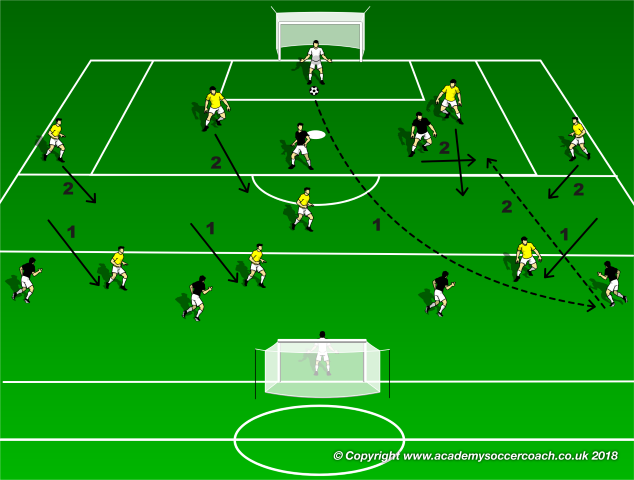
Set-up and Sequence: this exercise is a progression of the previous one. 14 field players and 2 goalkeepers are again placed inside an area about 10 yards less than a half of a regular field (or on half of a field) that is divided into 3 parts, as in the picture.
The black attacking team is shaped with 4 defenders (inside the first third) and 2 forwards (free to move inside the final third). The yellow team is shaped with 4 defenders inside the first third and 4 midfielders inside the middle third area of the space, at the beginning. The goalkeeper of the yellow team has the possession at the beginning. The attacking players can't play out of their areas, when in possession.
The goalkeeper starts the sequence, kicking the ball to a fullback of the black team, who must receive and try to play in behind the lines toward the forward, as soon as possible; 3 of the 4 midfielders of the defending team must put ultra-offensive pressure against the 4 black opponents, running inside the final third of the space, forcing the opposition building up phase backward or outside, to prevent them from playing toward the forwards (1).
The fourth midfielder must provide balance inside the middle third.
If the black forwards seem to be able to receive, the 4 at the back must run up in the middle third, trying to anticipate them or leaving them offside. 2 of the 4 defenders must press the potential receiver creating numerical advantage against him (2 v 1) - (2).
Defense transition phases:
1) If the yellow midfielders are able to recover the possession, they can counter-attack 3 v 4 with the fourth teammate as back support; the 4 blacks at the back must counter them, counter pressing thanks to the defensive numerical advantage.
2) If the yellow defenders recover the possession, they must pass the ball to the midfielders to try to score. The black defenders must counter them, delaying the possession phase of he opponents. The yellow forwards can run back to create defensive numerical advantage 6 v 4 after 6".
Tactical key points: pressure and balance at the back, anticipation, defend forward, condense the ball area, creation of defensive numerical advantage, delay to wait for teammates support.
Exercise 28: 4 - 2 v and gk v 1-4-4-2
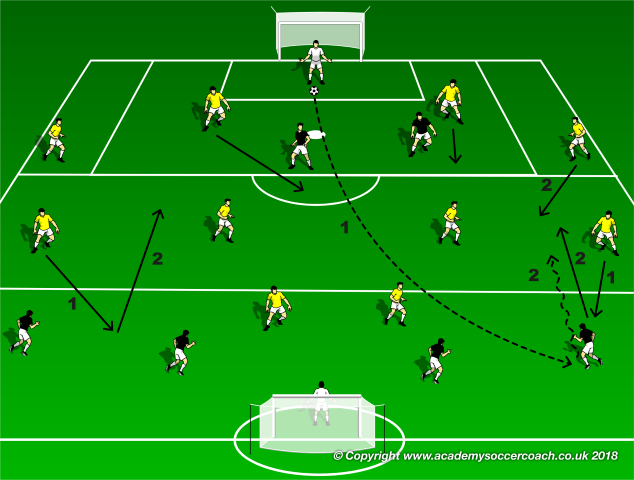
Set-up and Sequence: this exercise is another progression of number 26. 16 field players and 2 goalkeepers are placed inside a half of a regular field that is divided into 3 parts, as in the picture. The black attacking team is shaped with 4 defenders (inside the first third) and 2 forwards (free to move inside the final third). The yellow team is shaped with a 1-4-4-2 formation through the thirds of the field, at the beginning. The goalkeeper of the yellow team has the possession.
The goalkeeper starts the sequence, kicking the ball to a fullback of the black team, who must receive and try to dribble inside the next area; the closest opposition winger must try to counter him while receiving to prevent him from playing forward (1). The opposite winger must shift across to make the pitch smaller for the attacking team. The winger, the nearest center midfielder and forward must create a strong area near the ball.
If the black player is able to dribble forward, the yellow winger must track him back, while the fullback is running forward, toward the next third to close the space in front of him - (2). The strong area on the ball must be created again, following its direction.
Defense transition phases:
1) If the first pressure phase is successful, a 4+2 v 4 counter attack situation can be developed; the black defenders must try to delay the attacking phase of the opponents for 6", to allow the forward to run back, to equalize the duel (6 v 6)
2) If the ball is recovered in the middle third or inside the first third, then the new possession team must build up from the goalkeeper; the black team without possession must shape a 4 - 2 defense formation inside the final and middle third, to save the depth and the goal space.
Tactical key points: create a strong area near the ball, retreat to support the defense phase, re-organize a back 4 defense line and save the center space with the center midfielders.
Exercise 29: 1-4-4-2 v 1-4-4-2 (1)
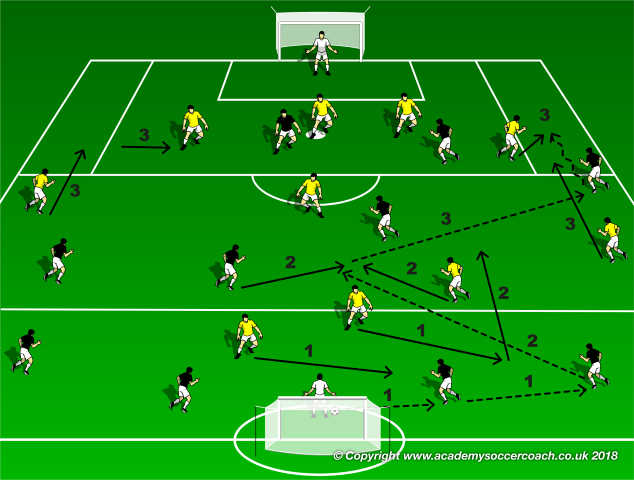
Set-up and Sequence: 20 field players and 2 goalkeepers are placed inside a half of a regular field that is divided into 3 parts, as in the picture. Both teams are placed with 4 defenders in the first third, 4 midfielders inside the middle third and 2 forwards inside the final third, at the beginning. The goalkeeper of the black possession team starts the sequence.
The yellow forwards must try to put pressure against the 2 first opponents in possession to force the direction of play wide (1). If the midfielders of the attacking team are able to receive, one of the forwards must run back in the middle third to create defensive numerical advantage 5 v 4 (2).
If the possession team is able to play inside the final third, thanks to a winger or a midfielder, who can dribble forward, both the wingers of the defending team must retreat to allow the defense line to shift across and to create a strong area on the ball and a safe numerical advantage inside the first third (3).
If the black player is able to dribble forward, the yellow winger must truck him back, while the fullback is running forward, toward the next third to close the space in front of him - (2). The strong area on the ball must be created again, following its direction.
Defense transition phases:
1) If the first pressure phase of pressure is successful, a 4+2 v 4+4 (defenders and midfielders) counter-attack situation can be developed; the black defenders must try to delay the attacking phase of the opponents for 6" (4 v 4+2), to allow the midfielders running back, creating a numerical advantage defense situation (8 v 6).
2) If the ball is recovered inside the middle third a 6 v 8 duel is played for 6"; if the new defending team is not able to counter press and to recover the possession within that time, then the attacking team can finish freely.
3) If the ball is recovered inside the first third, the possession team must build up from the back. The black team without possession must defend forward running up and placing the defense line inside the middle third, creating 2 defense lines very close to each other.
Tactical key points: create a strong area near the ball to force the opposition possession phase, delay, waiting for help of teammates, counter press if defending with numerical advantage, defend forward organizing 2 lines of 4 to avoid any in behind passes.
Exercise 30: 1-4-4-2 v 1-4-4-2 (2)
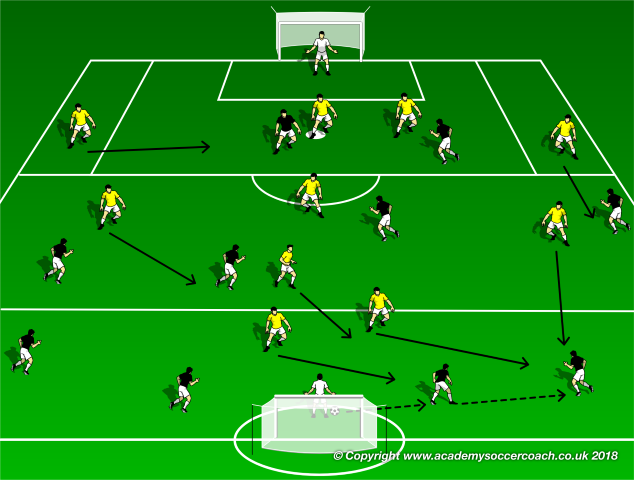
Set-up and Sequence: 20 field players and 2 goalkeepers are placed inside on a half of a regular field that is divided into 3 parts, as in the picture. Both teams are placed with 4 defenders in the first third, 4 midfielders inside the middle third and 2 forwards inside the final third, at the beginning. The goalkeeper of the black possession team starts the sequence.
The yellow forwards must try to put pressure against the 2 first opponents in possession, to force the direction of play wide or even to recover the possession, as 2 of the 4 midfielders run inside the final third, to create ultra-offensive pressure, equalizing the number of players; the other 2 midfielders provides balance in the middle third.
If the midfielders of the attacking team are able to receive, one of the fullbacks must run up to limit the defensive numerical disadvantage 4 v 3; the opposite fullback must shift across to shape a 3 back line together with the center backs.
If the possession team is able to play inside the final third, thanks to a winger or a midfielder, who can dribble forward, both the balance midfielders of the defending team must retreat to create defensive numerical advantage inside the first third.
Defense transition phases:
1) If the first pressure phase is successful, a 4 v 4 counter attack situation is developed; the black defenders must try to delay the attacking phase of the opponents for 6", to allow the wingers running back, creating a numerical advantage defense situation (6 v 4), where at least one player can move out of the line to counter the ball carrier.
2) If the ball is recovered in the middle third a 7 v 8 duel is played for 6"; if the new defending team is not able to counter press and to recover the possession within that time, then the attacking team can finish freely.
3) If the ball is recovered inside the first third, the possession team must build up from the back. The black team without possession must defend forward, running up and placing the defense line inside the middle third, creating 2 defense lines very closed to each other.
Tactical key points: create a strong area near the ball to force the opposition possession phase through an ultra-offensive pressure action, delay, waiting for help of teammates, counter press if defending with numerical advantage, defend forward organizing 2 lines of 4 to avoid any in behind passes.


